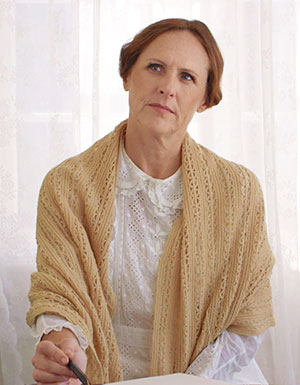It’s 1860. Two women, each roughly 30, meet in a drawing room and greet each other warmly with a kiss on each cheek. Then the lips. Then they lunge at one another, mouths meeting, hands grabbing lustily, before falling to the floor together.
To help keep this site running: Willow and Thatch may receive a commission when you click on any of the links on our site and make a purchase after doing so.
Cut to the opening title card of “Wild Nights With Emily.”
This is Emily Dickinson as few people know her. The Dickinson of public consciousness was a dour, death-obsessed shut-in who met with scant literary success and died a childless spinster. But this film, based on reassessments of her correspondence and dogged pursuit of the truth, presents a very different person.
With a raunchy-sounding title, a place in the comedy category, and a slapstick-happy “SNL” alum (Molly Shannon) in the lead role, “Wild Nights” sets certain expectations, then happily subverts them.
Shannon is understated and genuine, portraying Emily as a mature yet playful woman frustrated at having to conceal her love for her dear Susan (Susan Ziegler). Emily and Susan’s romance is portrayed as a lovely, delicate thing that blossoms when the two are teenagers. They write impassioned notes to one another, perform Shakespeare scenes in which they are conveniently cast as lovers, and kiss in quiet corners as soon as they’re left alone.
When Susan becomes betrothed to Emily’s brother, Austin (Kevin Seal), Emily is devastated. But the marriage means Susan and Emily will spend their lives as neighbors, able to send a love note next door or pay a visit to one another whenever they like. And boy, do they take up those opportunities.
Contrasting the playful nature of Emily and Susan’s trysts are Emily’s sitting-room meetings with various droning men, who recap Bronté novels incorrectly and tell Emily her poetry is feeble—too full of dashes, too imprecise in its evocation of emotion. Emily dutifully sits through these encounters, paying the socially required respect, but it is clear she’s exasperated by them. They don’t understand her. It is only when she is with Susan that she becomes fully accepted and radiantly self-possessed.
The vast majority of period dramas portray heterosexual love stories, but that does not mean LGBTQ people didn’t exist before the 20th century. “Wild Nights” is heartwarming in that it portrays two women in a long-term relationship—albeit one that had to be concealed—full of deep love, healthily resolved conflict, and mutual understanding. Lesbianism is not a punchline here, nor is same-sex love a source of shame for either Emily or Susan. The world around them doesn’t accept it, but that doesn’t mean it’s wrong.
“Wild Nights” is also not an anachronistic insertion of queerness into a straight historical story. Madeleine Olnek, the film’s writer and director, used Dickinson’s own letters and poetry as source material. The title comes from a poem she wrote circa 1861 that begins “Wild nights – Wild nights! / Were I with thee / Wild nights should be / Our luxury!” The assumption that “thee” is Susan is not so wild. When she was 21, Dickinson wrote this in a letter to her “Susie”:
Susie, forgive me Darling, for every word I say — my heart is full of you, none other than you in my thoughts, yet when I seek to say to you something not for the world, words fail me.
In the last few decades, the question of Dickinson’s sexuality has been examined by several authors, beginning with Rebecca Patterson’s The Riddle of Emily Dickinson in 1951. After Dickinson’s death, Susan’s name was literally erased from some of their surviving correspondence, and the word “she” changed to “he” in other writings.
I first came across an article in the New York Times in 1998, about how advancements in science allow us to understand new things about historical figures. One of the stories was about using spectrographic technologies to look at the erasures in Emily Dickinson’s papers. What was interesting about that article was that it talks about her papers, and how the erasures were all around the name Susan. But then there was a letter that wasn’t erased — and it was the most passionate, love-struck letter you’ve ever read, from Emily to Susan. – Director Madeleine Olnek
This suggests that those in charge of her estate sought to suppress evidence of Dickinson’s romantic feelings toward another woman. Historically, affectionate correspondence between women has often been interpreted as deep friendship, but the intimate female bonds and Boston marriages of the late 19th century deserve re-examination. This film is a portrayal of one such fresh look.
“Wild Nights” is not a sumptuously shot, high-budget film. Its actors don’t seem fully comfortable in their period costumes, though this is occasionally the source of comedy and an opportunity to reflect on the sartorial constraints 19th-century women had to contend with. The film contains few moments of great drama or conflict, and the off-kilter humor doesn’t always hit the mark.
But “Wild Nights With Emily” does something very meaningful: it presents a full-bodied portrait of a woman who seems to have been shortchanged and misrepresented in the annals of history. And it raises provocative questions: How many other lives have been retroactively altered to suit the social mores of the time? Whose stories have we been telling wrong?
Wild Nights with Emily (2019) is in theaters April 12.
Starring Molly Shannon, Susan Ziegler, Amy Seimetz, Brett Gelman.
Rated PG-13
“I love you as dearly, Susie, as when love first began, on the step at the front door, and under the Evergreens…” – Letter from Emily Dickinson to Susan Gilbert
Open Me Carefully: Emily Dickinson’s Intimate Letters to Susan Huntington Dickinson compiles selections from Emily Dickinson’s thirty-six year correspondence to her neighbor and sister-in-law, Susan Huntington Dickinson, are compiled in a single volume. “Open Me Carefully” invites a dramatic new understanding of Emily Dickinson’s life and work, overcoming a century of censorship and misinterpretation.
Ella Morton is a New Zealand-born, Australian-raised, Brooklyn-based writer focusing on overlooked aspects of history and culture. She co-wrote the New York Times bestselling book Atlas Obscura: An Explorer’s Guide to the World’s Hidden Wonders and wrote Outback, a photicular book about Australian animals (Workman, October 2019).
As Senior Editor at Atlas Obscura, Ella assigned and edited stories on history, culture, and exploration from over 80 global writers. Ella is now writing a historical non-fiction book while working on special projects with The History Channel.
If you enjoyed this post, be sure to see The Period Films List, with the best historical and costume dramas sorted by era. You’ll especially like the Best Period Dramas: Victorian Era list, and want to read the news about Dickinson, the new coming-of-age series from Apple.

